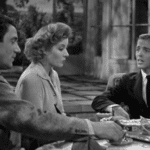Miyazaki’s Studio Ghibli filmography started incredibly strong from the jump, and as we know now there have been few (if any) misses in his catalog since. Still following My Neighbor Totoro had to be daunting, as its universal acclaim was and remains such that even non-anime fans recognize the iconography of Totoro. Miyazaki with his next film would then in 1989, for the first time in his Ghibli career (thus excluding Castle of Cagliostro), adapt a property not written by his own hand as he turned Eiko Kadono’s titular novel into a master film earning yet again incredible acclaim.
Kiki’s Delivery Service begins with a young witch who after turning thirteen flies away from her home to train in a great new city. Taking only her cat Jiji, a radio, and her mother’s broom, at first she fails to find her footing in the city. Now on guard Kiki pushes away a young boy, named Tombo, whose curiosity draws him closer to her, as he tries to befriend the young witch. After Kiki helps a local woman in the city, Osono, she returns the favor by allowing her to work for her, and encouraging Kiki to use her skills to start a delivery service.

Tombo and Kiki in Kiki’s Delivery Service (Source: GKIDS)
Along the way Kiki confronts many of the challenges confronted by girls her age, so often the protagonists of Miyazaki’s films, as she strives for independence and a place in the world, while still growing up herself. Kiki fortunately finds many incredible role models in the film, who help steer her on through life, and the introduction of young Tombo as a friend serves as both a friend and a potential (though unstated) first love.
In addition to themes of adolescence, Miyazaki also uses Kiki’s Delivery Service as an opportunity to showcase his fascination with flight, both with Kiki’s own powers, and also by Tombo’s own fascination with an airship. In the film’s climactic scene, you can see Miyazaki’s conflicting thoughts on technology, knowing there’s beauty in technology but also danger.
Now nearly thirty-five years later Kiki’s Delivery Service still holds up, as do so many Studio Ghibli films. Kiki’s story is timeless, and treasured by young women and men alike to this day, and no wonder. We may not all have been witches on our first flight; however, we all know what its like to seek out our own footing in life and to find pitfalls and support along the way.









